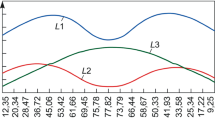The data of measurements of the power of radionavigation signals are accumulated for navigation satellites passing through special sections of their orbits. By analyzing these data, we reveal the variations of the power levels caused, possibly, by the changes in the angles of viewing of these satellites. We also describe the results of the observations of the navigation satellites performed by using various antenna systems. The obtained data are in good mutual agreement.



Similar content being viewed by others
References
M. I. Mikhailov, K. V. Muzalevskii, and V. L. Mironov, “Measurements of ice thickness in a fresh-water pond and in a river according to the GLONASS and GPS signals,” Sovr. Probl. Dist. Zond. Zemli Kosm., 14, No. 2, 167–174 (2017), http://d33.infospace/ru/d33_conf/sb2017t2/167-174.pdf, acc. 08.30.2017.
V. V. Kiryushkin and D. A. Cherepanov, “Bistatic location of air targets by the signals of satellite radionavigation systems,” Vestn. Voronezh Gos. Tekh. Univ., No. 11 (6), 33–38 (2010).
GLONASS Global Navigation Satellite System. Interface Control Document, Vers. 5.1, http://russianspacesystems. ru/wp-content/uploads/2016/08/IKD.-Obshh/-opis/-Red.-1.0-2016.pdf, acc. 01.17.2017.
A. S. Zavgorodnii, I. V. Ryabov, and V. L. Voronov, “Metrological complex for the estimation of the energy characteristics of signals of the navigation satellites of the GLONASS GNSS,” Alman. Sovr. Metrol., No. 7, 124–138 (2016).
A. S. Zavgorodnii, “On the calibration of a metrological complex intended for the estimation of the energy characteristics of signals of navigation satellites according to the complete transmission factor,” in: Metrology in the XXI Century: Abstr. Sci. Pract. Conf. of Young Scientists, Postgraduates, and Experts, Mendeleevo, March 2, 2016, VNIIFTRI, Mendeleevo (2016), pp. 151–157.
A. S. Zavgorodnii, “A method for the compensation of a frequency shift of the received navigation signal in power measurements,” in: Radionavigation Technologies, A. I. Perov (ed.) (2015), pp. 97–101.
A. V. Fateev, D. V. Emel’yanov, Yu. A. Tentilov, and A. V. Ovchinnikov, “Passing through special orbit sections by a navigation satellite of the GLONASS system,” Vestn. SibGAU, No. 4 (56), 126–131 (2014).
Navipaedia: Information-Reference Portal of the European Space Agency (ESA), http://navipedia.org/index.php/Carrier_Phase_Winf-up_Effect, acc. 01.17.2017.
W. A. Marquis and D. L. Reigh, “The GPS block IIR and IIR-M broadcast L-band antenna panel: its pattern and performance,” Navigation, 62, No. 4, 329–347 (2015).
Author information
Authors and Affiliations
Corresponding author
Additional information
Translated from Izmeritel’naya Tekhnika, No. 2, pp. 20–23, February, 2018.
Rights and permissions
About this article
Cite this article
Denisenko, O.V., Fedotov, V.N., Voronov, V.L. et al. Results of Observations of Navigation Satellites in Special Sections of Their Orbits. Meas Tech 61, 116–119 (2018). https://doi.org/10.1007/s11018-018-1396-3
Received:
Published:
Issue Date:
DOI: https://doi.org/10.1007/s11018-018-1396-3



